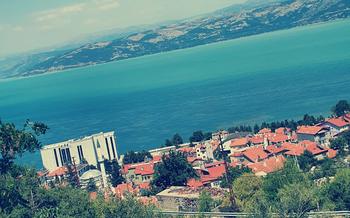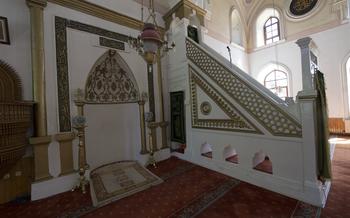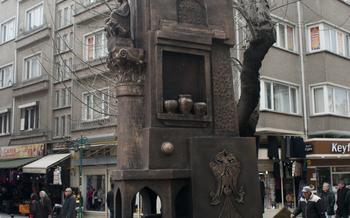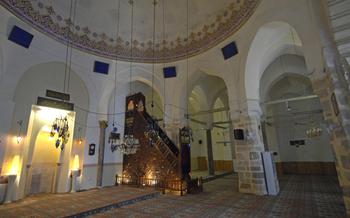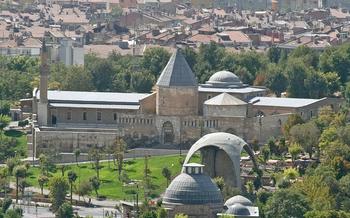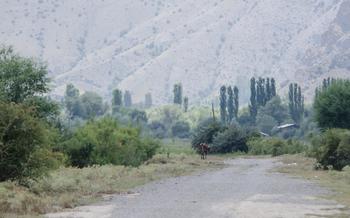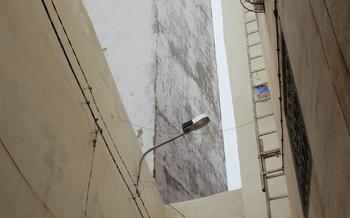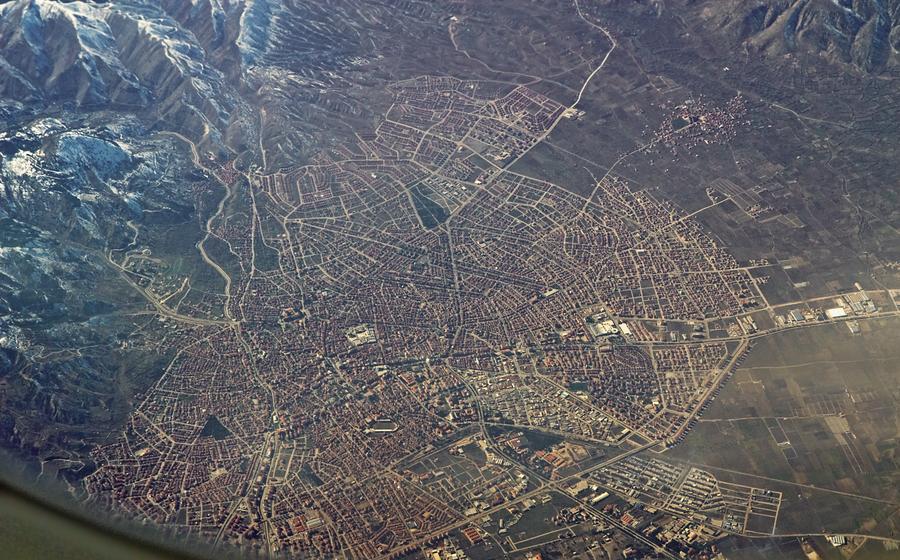
Senirkent Ulu Mosque
- The Antiquity of Isparta's Great Mosque
- The People Behind the Mosque's Creation
- Unique Architectural Elements
- The Mosque's Role in the Community
- The Mosque's Interior Splendor
- The Serenity of the Mosque's Courtyard
- Historical Significance of the Mosque
- Visiting the Mosque: Practical Information
- Local Artisans and Handicrafts
- Local Cuisine and Culinary Delights
- Exploring the City of Isparta
- Accommodation Options in Isparta: A Guide for Travelers
- Transportation to and from Isparta
- Recommended Time to Visit
- Insider Tip: Unveiling Isparta's Hidden Treasures
The Antiquity of Isparta's Great Mosque
The Senirkent Ulu Mosque stands as a testament to the rich history and cultural heritage of Isparta, Turkey. Its origins date back to the 13th century, during the reign of the Seljuk Sultanate. The mosque was commissioned by the Seljuk governor of Isparta, Emir Senirkent Hüseyin Bey, who envisioned a grand and imposing structure that would serve as the spiritual and religious center of the city.
The mosque's architectural style reflects the Seljuk's distinct blend of Persian and Anatolian influences. Its exterior features intricate carvings and decorative elements, while the interior boasts a spacious prayer hall adorned with exquisite calligraphy and tilework. Over the centuries, the mosque has undergone several renovations and additions, incorporating elements of Ottoman architecture, reflecting the city's changing political and cultural landscape.
Throughout its history, the Senirkent Ulu Mosque has served as a focal point for the local community, not only as a place of worship but also as a center of education and social gatherings. Its religious significance has endured, and it remains a vibrant and active mosque, welcoming worshippers and visitors alike.
The People Behind the Mosque's Creation
The story of the Senirkent Ulu Mosque is intertwined with the devotion and dedication of its founders and the local community. According to local legend, the mosque was built by a pious man named Hacı Ahmet Efendi, who was deeply devoted to his faith. He embarked on a journey to find the ideal location for the mosque, guided by divine dreams and visions. Upon arriving in Senirkent, he felt an overwhelming sense of peace and tranquility, convinced that this was the chosen site.
The construction of the mosque was a community effort, with the local people wholeheartedly supporting the project. They contributed their time, resources, and skills to bring Hacı Ahmet Efendi's vision to life. Artisans and craftsmen from the region poured their hearts and souls into creating the intricate carvings, calligraphy, and tilework that adorn the mosque's interior and exterior. Every stone, every tile, and every intricate detail bears witness to the unwavering faith and dedication of the people who built this magnificent house of worship.
Over the centuries, stories and legends have been woven around the construction of the mosque, adding to its mystique and allure. One tale speaks of a miraculous spring that appeared on the site, providing water for the construction workers and symbolizing the divine blessing upon the project. Another legend tells of a mysterious stranger who appeared during the construction, offering his unparalleled skills as a craftsman and then disappearing without a trace, leaving behind a legacy of awe and wonder.
Unique Architectural Elements
The Senirkent Ulu Mosque stands out for its distinctive architectural features that reflect the fusion of Seljuk and Ottoman styles. Its towering minaret, adorned with intricate carvings and colorful tiles, is a testament to the craftsmanship of the era. The mosque's entrance, framed by a majestic archway, welcomes visitors with an aura of grandeur.
Inside, the mosque's prayer hall captivates with its vastness and intricate details. The ceiling, a masterpiece of design, is supported by rows of elegant columns, creating a sense of awe and symmetry. Each column is adorned with unique carvings, showcasing floral motifs and geometric patterns, a testament to the artisans' meticulous attention to detail.
The walls of the mosque are adorned with exquisite calligraphy, verses from the Quran inscribed in beautiful Arabic script. The vibrant colors and intricate designs of the calligraphy add to the mosque's spiritual ambiance, creating an environment conducive to contemplation and prayer.
The Mosque's Role in the Community
The Senirkent Ulu Mosque has served as the spiritual and social heart of the community for centuries. As a place of worship, it brings together Muslims from all walks of life to pray, learn, and celebrate their faith. The mosque's spacious prayer hall can accommodate large congregations, fostering a sense of unity and brotherhood among worshippers.
Beyond its religious significance, the mosque also serves as a vital gathering place for social and cultural events. Locals often congregate in the courtyard or the prayer hall to discuss community matters, organize social gatherings, and celebrate important milestones. The mosque's serene atmosphere and central location make it an ideal venue for these events, strengthening the bonds within the community.
The mosque's presence has a profound impact on the local economy. As a tourist attraction, it draws visitors from near and far, generating revenue for local businesses. Visitors often spend money on souvenirs, food, and accommodation, contributing to the economic development of the region. The mosque's popularity also creates job opportunities for locals, who can work as guides, vendors, or hospitality staff.
The Mosque's Interior Splendor
The interior of the Senirkent Ulu Mosque is an awe-inspiring sight that leaves visitors mesmerized. The prayer hall, with its soaring columns and intricate ceiling, creates an atmosphere of grandeur and spirituality. The walls and ceilings are adorned with exquisite decorations and artwork, including intricate carvings, colorful tilework, and elegant calligraphy. These decorative elements showcase the skill and artistry of the mosque's builders and add to its overall magnificence.
The unique acoustics of the prayer hall enhance the spiritual experience for worshippers. The carefully designed space allows sound to reverberate and amplify, creating a sense of harmony and tranquility. The melodious recitation of the Quran and the rhythmic chanting of prayers echo through the hall, filling the air with a divine resonance that touches the hearts of all who hear it.
The Serenity of the Mosque's Courtyard
As you step into the courtyard of the Senirkent Ulu Mosque, a sense of tranquility washes over you. The courtyard, with its verdant greenery and manicured gardens, provides a soothing contrast to the bustling city outside. The gentle breeze rustles through the leaves of the trees, creating a calming symphony that invites you to pause and reflect.
The courtyard's serene atmosphere is further enhanced by the intricate designs and patterns adorning the surrounding walls and arches. Verses from the Quran, etched in elegant calligraphy, add a spiritual dimension to the space. The courtyard also features a beautiful fountain, whose gentle splashing adds to the overall tranquility.
Whether you choose to sit on one of the benches and soak in the serenity or simply wander around the courtyard, admiring its architectural details, you will find that it is the perfect place to escape the hustle and bustle of everyday life and find a moment of peace and reflection.
The courtyard is not just a place for contemplation and prayer; it also serves as a gathering place for the community. During festivals and special occasions, the courtyard transforms into a vibrant venue for celebrations and gatherings. The sound of laughter and music fills the air as people come together to share stories, celebrate traditions, and foster a sense of community.
The courtyard of the Senirkent Ulu Mosque is a true oasis of tranquility, a place where visitors can find solace, connect with their spirituality, and experience the warmth of the local community.
Historical Significance of the Mosque
The Senirkent Ulu Mosque stands as a testament to the rich cultural heritage of Isparta, deeply entwined with the region's history. Built during the Seljuk period, the mosque holds immense significance as a symbol of the city's past. Its enduring presence has witnessed numerous historical events and played a pivotal role in shaping the cultural and religious landscape of the region. The mosque's architectural style reflects the Seljuk's mastery of stonework and their distinct artistic traditions. Over the centuries, the mosque has undergone several renovations and additions, each reflecting the changing political and cultural dynamics of the time. Today, the Senirkent Ulu Mosque serves as a living embodiment of Isparta's rich past, connecting its present with its historical roots.
Visiting the Mosque: Practical Information
As you prepare to visit the Senirkent Ulu Mosque, it is essential to be mindful of cultural etiquette and dress appropriately. Visitors should opt for modest attire that covers the shoulders and knees. While inside the mosque, maintaining silence and respecting the worshippers' tranquility is crucial. Photography is generally permitted, but it is advisable to seek permission and avoid using flash to prevent disturbing others.
To capture the mosque's beauty in your photographs, consider arriving early in the morning or late in the afternoon when the sunlight casts a golden glow on the architecture. Experiment with different angles and perspectives to showcase the intricate details and grandeur of the mosque. Guided tours are available for those who wish to delve deeper into the mosque's history and significance. These tours provide valuable insights and anecdotes that enhance the overall experience.
Local Artisans and Handicrafts
Isparta is home to a vibrant community of local artisans who keep traditional crafts alive. In workshops scattered throughout the city, skilled hands create exquisite carpets, intricate pottery, and beautiful jewelry. Visitors can witness the artisans at work, marveling at their talent and attention to detail.
One of the most renowned crafts in Isparta is carpet weaving. The city's carpets are known for their vibrant colors, intricate designs, and superior quality. Each carpet is a unique work of art, painstakingly handcrafted over many months. Visitors can find a wide variety of carpets to choose from, ranging from traditional patterns to contemporary designs.
Pottery is another important craft in Isparta. Local potters use local clay to create a variety of functional and decorative pieces, including plates, bowls, vases, and tiles. The pottery is often adorned with intricate patterns and vibrant colors, making each piece a unique work of art.
Isparta is also known for its beautiful jewelry. Local artisans create stunning pieces using gold, silver, and gemstones. The jewelry is often inspired by traditional Turkish designs, featuring intricate filigree work and colorful enamel. Visitors can find a wide variety of jewelry to choose from, including necklaces, bracelets, earrings, and rings.
By purchasing handmade souvenirs from local artisans, visitors not only take home a piece of Isparta's culture but also support the local economy and help preserve traditional crafts.
Local Cuisine and Culinary Delights
Isparta's culinary scene is a delightful blend of traditional Turkish flavors and regional specialties. Sütlaç, a creamy rice pudding topped with cinnamon, is a beloved dessert not to be missed. Savor the rich taste of Isparta kebabı, tender lamb grilled to perfection and served with a flavorful tomato sauce. For a taste of local bread, try pide, a flatbread topped with various fillings such as cheese, meat, or vegetables.
When visiting the mosque, take the opportunity to explore the surrounding area and indulge in local delicacies. Konyalı Et Lokantası, just a short walk from the mosque, serves mouthwatering grilled meats and traditional Turkish dishes. For a quick bite, try Köfteci Ahmet Usta, famous for its flavorful meatballs.
Insider Tip: For a unique culinary experience, visit the Isparta Farmers' Market, held every Saturday. Here, you can find fresh produce, local cheeses, and handmade products, allowing you to savor the authentic flavors of the region.
Exploring the City of Isparta
While the Senirkent Ulu Mosque stands as the crown jewel of Isparta, the city itself is a treasure trove of historical and cultural wonders waiting to be explored. Stroll through the charming streets, where ancient and modern architecture blend harmoniously, and uncover hidden gems at every corner. Admire the grandeur of the 14th-century Ulu Camii, with its intricate carvings and serene atmosphere. Step back in time at the Isparta Museum, where artifacts from the city's rich past are lovingly preserved and displayed.
For a taste of local culture, visit the bustling Isparta Bazaar, where vendors showcase their wares, from traditional textiles to handcrafted pottery. Indulge in the city's renowned cuisine, savoring the flavors of mouthwatering kebabs, aromatic pilafs, and the famous Isparta Rose Delight, a sweet treat made from the region's prized roses. As evening falls, soak in the vibrant atmosphere of the city's squares and parks, where locals gather to socialize, sip tea, and enjoy live performances. Isparta offers a harmonious blend of history, culture, and modern amenities, ensuring an unforgettable visit for every traveler.
Accommodation Options in Isparta: A Guide for Travelers
Isparta offers a diverse range of accommodation options catering to different needs and budgets. From budget-friendly guesthouses to luxurious hotels, there's something for every traveler.
For backpackers and budget-conscious travelers, there are numerous guesthouses and hostels scattered throughout the city. These establishments provide basic yet comfortable accommodations at affordable rates. Some popular options include the Isparta Hostel, the Rose Garden Hostel, and the Backpacker's Den.
Mid-range hotels offer a good balance of comfort and value. These hotels typically feature clean and well-maintained rooms, along with amenities like air conditioning, private bathrooms, and Wi-Fi. Recommended mid-range hotels include the Grand Isparta Hotel, the Ramada Isparta, and the Park Inn by Radisson Isparta.
For those seeking a luxurious stay, Isparta boasts several high-end hotels that offer upscale amenities and services. These hotels often have elegant rooms, fine dining restaurants, and state-of-the-art fitness centers. Notable luxury hotels include the Hilton Garden Inn Isparta, the Wyndham Grand Isparta, and the Divan Isparta.
When choosing your accommodation, consider factors such as location, budget, and desired amenities. If you're looking to be close to the city center and major attractions, opt for a hotel or guesthouse in the historic district. For a more tranquil experience, consider staying in one of the city's charming neighborhoods, such as Gümüşlük or Davraz.
To find the best deals and book your accommodation in advance, it's recommended to use online booking platforms or contact the hotels directly. Remember to check for discounts and special offers, especially during the off-season. With its range of accommodation options, Isparta ensures a comfortable and memorable stay for travelers of all types.
Transportation to and from Isparta
Isparta is conveniently connected to major cities in Turkey, making it accessible by various transportation means.
-
By Air:
- Isparta Süleyman Demirel Airport (ISE) offers direct flights to and from Istanbul, Ankara, and Izmir.
- From the airport, you can take a taxi or rent a car to reach the city center.
-
By Bus:
- Isparta has a well-connected bus network, with regular services to and from major cities like Antalya, Denizli, and Burdur.
- The bus station is conveniently located near the city center, and tickets can be purchased in advance or upon arrival.
-
By Train:
- Isparta is not directly connected by rail to other cities.
- However, you can take a train to nearby Denizli or Burdur and then transfer to a bus or taxi to reach Isparta.
Tips for Planning Your Journey:
- Book your tickets in advance, especially during peak tourist seasons or for popular flights and bus routes.
- Consider renting a car if you prefer the flexibility of exploring the region at your own pace.
- Check the latest transportation schedules and routes to avoid any disruptions or delays.
Recommended Time to Visit
The best time to visit Isparta is during spring (April-May) or autumn (September-November) when the weather is pleasant and mild. During these seasons, you can comfortably explore the city's attractions without the scorching summer heat or the chilly winter cold.
Isparta also hosts several festivals and events throughout the year that offer a glimpse into the city's rich culture and heritage. One of the most popular events is the Isparta Rose Festival, held annually in May. This festival celebrates the region's famous roses and features parades, exhibitions, and traditional performances.
To avoid crowds and enjoy a more tranquil experience, consider visiting Isparta during the shoulder seasons (March-April and October-November). During these periods, the weather is still favorable, but the city is less crowded, allowing you to explore at your own pace.
Insider Tip: Unveiling Isparta's Hidden Treasures
Beyond the iconic Senirkent Ulu Mosque, Isparta holds a treasure trove of hidden gems waiting to be discovered. For an authentic glimpse into the city's soul, venture off the beaten path and explore these lesser-known wonders:
-
The Hidden Waterfall: Nestled amidst lush greenery, this secluded waterfall offers a tranquil escape from the urban hustle. Take a refreshing dip in its crystal-clear waters and immerse yourself in nature's embrace.
-
The Secret Garden: Tucked away behind an unassuming doorway, this enchanting garden is a haven of tranquility, adorned with vibrant flowers, aromatic herbs, and the gentle murmur of a hidden fountain.
-
The Old Town: Step back in time as you wander through the narrow cobblestone streets of Isparta's old town, where history whispers from every corner. Admire the charming Ottoman architecture and discover hidden courtyards and shops showcasing traditional crafts.
Embrace the spirit of adventure and let Isparta's hidden treasures captivate your senses. These off-the-beaten-path experiences will leave you with lasting memories and a deeper appreciation for this vibrant city.
